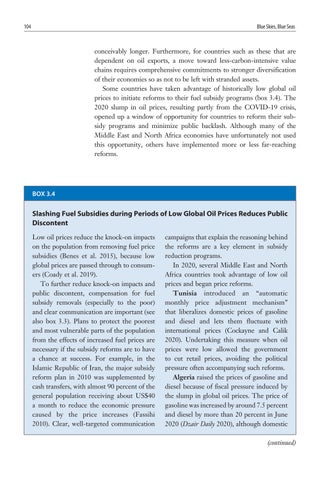104
Blue Skies, Blue Seas
conceivably longer. Furthermore, for countries such as these that are dependent on oil exports, a move toward less-carbon-intensive value chains requires comprehensive commitments to stronger diversification of their economies so as not to be left with stranded assets. Some countries have taken advantage of historically low global oil prices to initiate reforms to their fuel subsidy programs (box 3.4). The 2020 slump in oil prices, resulting partly from the COVID-19 crisis, opened up a window of opportunity for countries to reform their subsidy programs and minimize public backlash. Although many of the Middle East and North Africa economies have unfortunately not used this opportunity, others have implemented more or less far-reaching reforms.
BOX 3.4
Slashing Fuel Subsidies during Periods of Low Global Oil Prices Reduces Public Discontent Low oil prices reduce the knock-on impacts on the population from removing fuel price subsidies (Benes et al. 2015), because low global prices are passed through to consumers (Coady et al. 2019). To further reduce knock-on impacts and public discontent, compensation for fuel subsidy removals (especially to the poor) and clear communication are important (see also box 3.3). Plans to protect the poorest and most vulnerable parts of the population from the effects of increased fuel prices are necessary if the subsidy reforms are to have a chance at success. For example, in the Islamic Republic of Iran, the major subsidy reform plan in 2010 was supplemented by cash transfers, with almost 90 percent of the general population receiving about US$40 a month to reduce the economic pressure caused by the price increases (Fassihi 2010). Clear, well-targeted communication
campaigns that explain the reasoning behind the reforms are a key element in subsidy reduction programs. In 2020, several Middle East and North Africa countries took advantage of low oil prices and began price reforms. Tunisia introduced an “automatic monthly price adjustment mechanism” that liberalizes domestic prices of gasoline and diesel and lets them fluctuate with international prices (Cockayne and Calik 2020). Undertaking this measure when oil prices were low allowed the government to cut retail prices, avoiding the political pressure often accompanying such reforms. Algeria raised the prices of gasoline and diesel because of fiscal pressure induced by the slump in global oil prices. The price of gasoline was increased by around 7.5 percent and diesel by more than 20 percent in June 2020 (Dzair Daily 2020), although domestic (continued)






